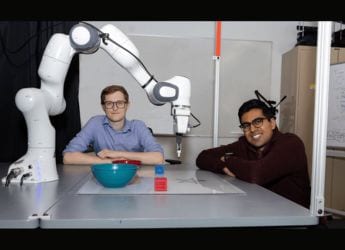- Home
- Others
- Others News
- 1888 Edison recording may be 1st talking doll try
1888 Edison recording may be 1st talking doll try
By Associated Press | Updated: 5 June 2012 01:59 IST

Click Here to Add Gadgets360 As A Trusted Source

Advertisement
Scientists using advanced imaging technology have recovered a 123-year-old recording made by Thomas Edison that is believed to be the world's first attempt at a talking doll and may mark the dawn of the American recording industry.
In the sound recording, a woman can be heard reciting a verse of "Twinkle, Twinkle, Little Star." Historians believe Edison hired the woman to make the recording less than two years before he unsuccessfully put the first talking doll on the market.
"Based on the date of fall 1888, it is the oldest American-made recording of a woman's voice that we can listen to today," said Patrick Feaster, a historian at Indiana University in Bloomington.
Feaster pored over historical documents and 19th-century newspaper reports to piece together the story behind the recording. Edison hoped to mass-produce the toys, but the era's rudimentary technology meant that to make 100 dolls, Edison would have to get artists to recite the lullaby 100 times.
"They must have been hired and paid to do this," Feaster said. "These were presumably the first professional recording artists."
The small piece of ring-shaped tin bearing the woman's voice never made it into a doll because wax records replaced metal ones by 1890, when Edison started selling his first talking dolls. Those fragile and easily broken toys were a market flop.
Yet almost 80 years after the mystery woman lent her voice to Edison, the recording showed up in 1967 in the archives of the Thomas Edison National Historical Park in West Orange, having been recovered from a secretary's desk drawer in Edison's laboratory.
"It was clear from looking under the microscope that it had a sound recording on it. Phonograph grooves have a familiar shape," said Jerry Fabris, a museum curator with the National Park Service.
But the metal ring - about 2.5 inches around and half an inch wide - was so bent and damaged that scientists couldn't play it.
More than four decades later, scientists at the Lawrence Berkeley National Laboratory in Berkeley, Calif., used image analysis in May to create a digital model of the record's surface. That model was then used to reproduce the recording as a digital file, not unlike the modern technology behind the voice that emerges from today's talking dolls.
In the sound recording, a woman can be heard reciting a verse of "Twinkle, Twinkle, Little Star." Historians believe Edison hired the woman to make the recording less than two years before he unsuccessfully put the first talking doll on the market.
"Based on the date of fall 1888, it is the oldest American-made recording of a woman's voice that we can listen to today," said Patrick Feaster, a historian at Indiana University in Bloomington.
Feaster pored over historical documents and 19th-century newspaper reports to piece together the story behind the recording. Edison hoped to mass-produce the toys, but the era's rudimentary technology meant that to make 100 dolls, Edison would have to get artists to recite the lullaby 100 times.
"They must have been hired and paid to do this," Feaster said. "These were presumably the first professional recording artists."
The small piece of ring-shaped tin bearing the woman's voice never made it into a doll because wax records replaced metal ones by 1890, when Edison started selling his first talking dolls. Those fragile and easily broken toys were a market flop.
Yet almost 80 years after the mystery woman lent her voice to Edison, the recording showed up in 1967 in the archives of the Thomas Edison National Historical Park in West Orange, having been recovered from a secretary's desk drawer in Edison's laboratory.
"It was clear from looking under the microscope that it had a sound recording on it. Phonograph grooves have a familiar shape," said Jerry Fabris, a museum curator with the National Park Service.
But the metal ring - about 2.5 inches around and half an inch wide - was so bent and damaged that scientists couldn't play it.
More than four decades later, scientists at the Lawrence Berkeley National Laboratory in Berkeley, Calif., used image analysis in May to create a digital model of the record's surface. That model was then used to reproduce the recording as a digital file, not unlike the modern technology behind the voice that emerges from today's talking dolls.
Comments
Get your daily dose of tech news, reviews, and insights, in under 80 characters on Gadgets 360 Turbo. Connect with fellow tech lovers on our Forum. Follow us on X, Facebook, WhatsApp, Threads and Google News for instant updates. Catch all the action on our YouTube channel.
Further reading:
Thomas Edison, talking doll
Related Stories
Popular on Gadgets
- Samsung Galaxy Unpacked 2025
- ChatGPT
- Redmi Note 14 Pro+
- iPhone 16
- Apple Vision Pro
- Oneplus 12
- OnePlus Nord CE 3 Lite 5G
- iPhone 13
- Xiaomi 14 Pro
- Oppo Find N3
- Tecno Spark Go (2023)
- Realme V30
- Best Phones Under 25000
- Samsung Galaxy S24 Series
- Cryptocurrency
- iQoo 12
- Samsung Galaxy S24 Ultra
- Giottus
- Samsung Galaxy Z Flip 5
- Apple 'Scary Fast'
- Housefull 5
- GoPro Hero 12 Black Review
- Invincible Season 2
- JioGlass
- HD Ready TV
- Laptop Under 50000
- Smartwatch Under 10000
- Latest Mobile Phones
- Compare Phones
Latest Gadgets
- Huawei Nova 15
- Huawei Nova 15 Pro
- Huawei Nova 15 Ultra
- OnePlus 15R
- Realme Narzo 90x 5G
- Realme Narzo 90 5G
- Vivo S50 Pro Mini
- Vivo S50
- Asus ProArt P16
- MacBook Pro 14-inch (M5, 2025)
- Huawei MatePad 11.5 (2026)
- OnePlus Pad Go 2 (5G)
- OnePlus Watch Lite
- Just Corseca Skywatch Pro
- Acerpure Nitro Z Series 100-inch QLED TV
- Samsung 43 Inch LED Ultra HD (4K) Smart TV (UA43UE81AFULXL)
- Asus ROG Ally
- Nintendo Switch Lite
- Haier 1.6 Ton 5 Star Inverter Split AC (HSU19G-MZAID5BN-INV)
- Haier 1.6 Ton 5 Star Inverter Split AC (HSU19G-MZAIM5BN-INV)
© Copyright Red Pixels Ventures Limited 2025. All rights reserved.
-
 NASA’s SPHEREx Telescope Delivers First Full-Sky Map, Unlocking Cosmic Secrets
NASA’s SPHEREx Telescope Delivers First Full-Sky Map, Unlocking Cosmic Secrets
-
 Robotic Arm Achieves 1,000 Tasks in a Day Through Innovative Imitation Learning
Robotic Arm Achieves 1,000 Tasks in a Day Through Innovative Imitation Learning
-
 Ponies OTT Release Date: Know When to Watch This Emilia Clarke and Haley Lu Richardson starrer web series online
Ponies OTT Release Date: Know When to Watch This Emilia Clarke and Haley Lu Richardson starrer web series online
-
 Bhabhi Ji Ghar Par Hain 2.0 Now Streaming Online: What You Need to Know
Bhabhi Ji Ghar Par Hain 2.0 Now Streaming Online: What You Need to Know










